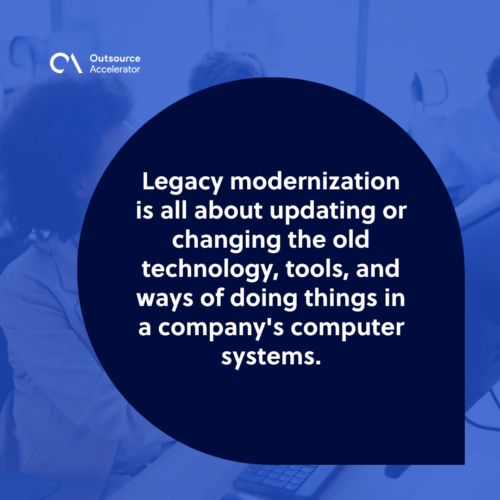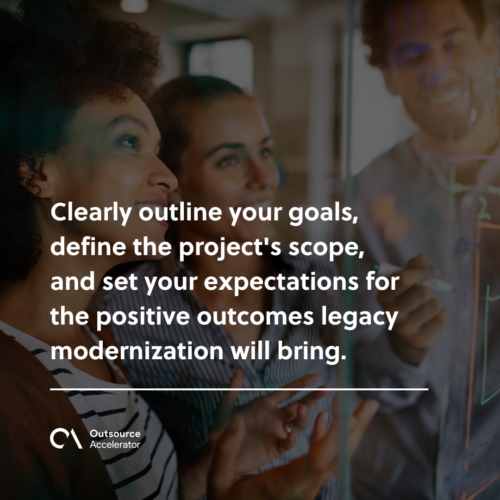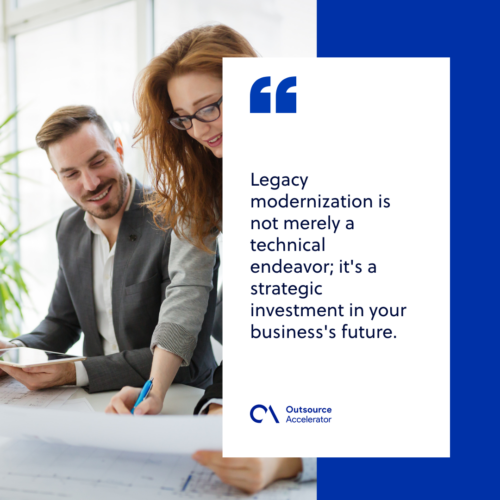Your 6-step guide to legacy modernization

Are you familiar with legacy systems? These systems were developed using older technologies, coding languages, and architectures.
These old processes may no longer be compatible with modern software and hardware. As a result, the system is vulnerable to potential data breaches and performance issues.
Legacy modernization has emerged as a crucial strategy to tackle this challenge.
This article explores what legacy modernization entails and why it’s essential. We’ll also provide a detailed six-step process to modernize your legacy systems successfully.
Defining legacy systems
Legacy systems refer to older technology or software an organization has used for a long time. These systems were once considered new and useful, but as time goes on, they can cause problems for the company.
Some common things about legacy systems are that they use outdated programming languages, which are the instructions the system follows. Because of this outdated process, legacy systems have trouble working with newer systems.
Another issue of legacy systems is that they can’t easily grow or handle more work if the company gets bigger or needs to do more things.
This lack of adaptability makes it challenging for the company to keep up with new demands and changes in the business world.
What is legacy modernization?
Legacy modernization is all about updating or changing the old technology, tools, and ways of doing things in a company’s computer systems.
The main goal of legacy modernization is to improve these systems and help the company be more efficient.
It also matches what the business needs and new technology can offer. This can involve small improvements like updating software or big changes like completely redoing how the computer systems are set up.
Legacy modernization also keeps the company’s technology up to date to work well with today’s needs and advancements.

Why should you modernize your legacy system?
Legacy modernization might seem like a daunting task, but the benefits it offers are well worth the effort.
Here are the main reasons why you should go for legacy modernization:
Improved efficiency and productivity
Legacy systems frequently encounter inefficiencies stemming from outdated processes and technology. These systems can be revamped by legacy modernization, resulting in streamlined workflows.
Legacy modernization also reduces reliance on manual interventions. This overhaul enhances overall efficiency. It also enables employees to dedicate time to tasks that contribute value rather than struggling with older technology.
Scalability and future-readiness
For a business to thrive, its ability to scale is paramount. Unfortunately, legacy systems tend to struggle when faced with accommodating growth.
In contrast, modernized systems are built to scale seamlessly. Legacy modernization empowers businesses to expand their operations without being hindered by the constraints of outdated technology.
Enhanced user experience
As user expectations evolve, providing a satisfying experience is crucial. Legacy systems often struggle to deliver the intuitive interactions that users now expect.
Through legacy modernization, businesses can create interfaces that prioritize user needs. This increases user satisfaction and enhances overall productivity as tasks become more streamlined and user-friendly.
6 steps for legacy modernization
Modernizing a legacy system requires a structured approach to ensure a successful transformation.
Here are the six crucial steps to guide you through the process:
Step 1: Assessment and planning
At the beginning of your legacy modernization journey, perform a detailed assessment of your current legacy system.
This involves examining every nook and cranny of your existing setup to identify where it’s falling short and causing challenges.
Look for pain points, inefficiency, and bottlenecks hindering productivity. With these insights, create a well-thought-out plan for the modernization process.
Clearly outline your goals, define the project’s scope, and set your expectations for the positive outcomes legacy modernization will bring. This plan acts as a roadmap that guides you through the steps needed to transform your legacy system into a more effective solution.
Step 2: Technology selection
Selecting the right technology is a cornerstone of successful legacy modernization. Carefully evaluate and choose a technology stack that aligns with your business needs and long-term objectives.
Consider factors such as:
- How well the chosen technology integrates with your existing tools
- How can its scalability accommodate your future growth
- The level of security your chosen technology provides
Whether you’re leaning towards cloud-based solutions or on-premises systems, ensure they seamlessly merge with your vision for the organization’s future.
Keep in mind that your chosen technology will be the foundation for your modernized system, so decide wisely.
Step 3: Data migration and integration
Data is the beating heart of any organization, and during legacy modernization, safeguarding this valuable asset is paramount.
Plan a smooth data migration from your legacy system to the new environment. This process requires meticulous attention to detail to prevent data loss or corruption.
Additionally, consider how the newly modernized system will interact with other applications in your ecosystem.

Step 4: Development and implementation
Once you’ve settled on the technology stack, it’s time to dive into development and implementation. This phase of legacy modernization involves coding, configuring, and customizing the new system to align with your business requirements.
As you make these changes, strike a balance between incorporating fresh features and retaining functionalities that have proven effective.
This step bridges the gap between your legacy system and the modernized version, ensuring a smooth transition that doesn’t disrupt your day-to-day operations.
Step 5: Testing and quality assurance
Testing is the safety net that catches potential issues before they reach the end users. Rigorous testing is a non-negotiable step in legacy modernization.
Thoroughly assess the modernized system for functionality, security, performance, and compatibility.
Any glitches, vulnerabilities, or inconsistencies arising during testing should be addressed promptly to ensure the final product is stable, reliable, and current.
Step 6: Training and change management
Introducing a modernized system to your team requires them to adapt and learn new working methods.
Provide comprehensive training to employees to help them become familiar with the modern system’s features and processes. Understand that there might be resistance to change, and that’s where change management strategies come into play.
Smoothen the transition by addressing concerns, showcasing the new system’s benefits, and fostering a positive mindset toward the change.
Furthermore, investing in training and change management sets the stage for a successful and sustainable legacy modernization outcome.

Legacy modernization sustains business growth and innovation
Legacy modernization is not merely a technical endeavor; it’s a strategic investment in your business’s future. By following the comprehensive six-step guide outlined above, you can confidently navigate the complexities of modernization.
Itransition, a globally renowned engineering company, offers application modernization services that provide businesses the agility, scalability, and efficiency required to adapt to market dynamics and stay competitive.
Modernized systems provide the agility, scalability, and efficiency required to adapt to market dynamics and stay competitive.







 Independent
Independent




